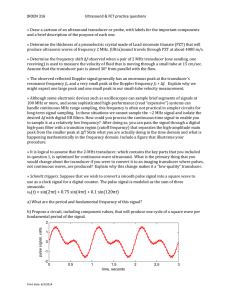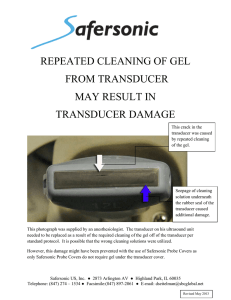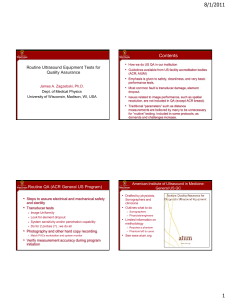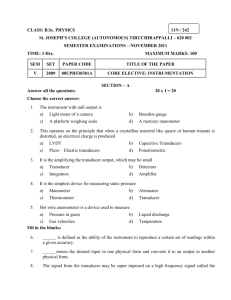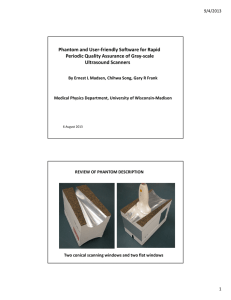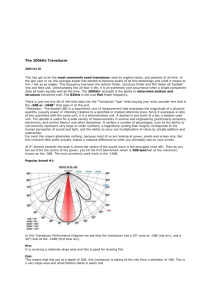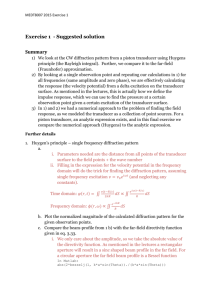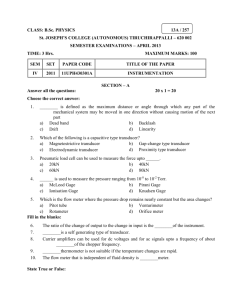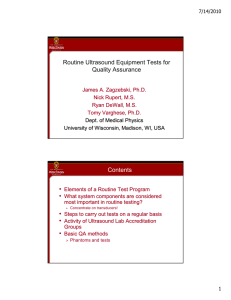Performance Testing Of Medical Ultrasound Equipment James A. Zagzebski
advertisement
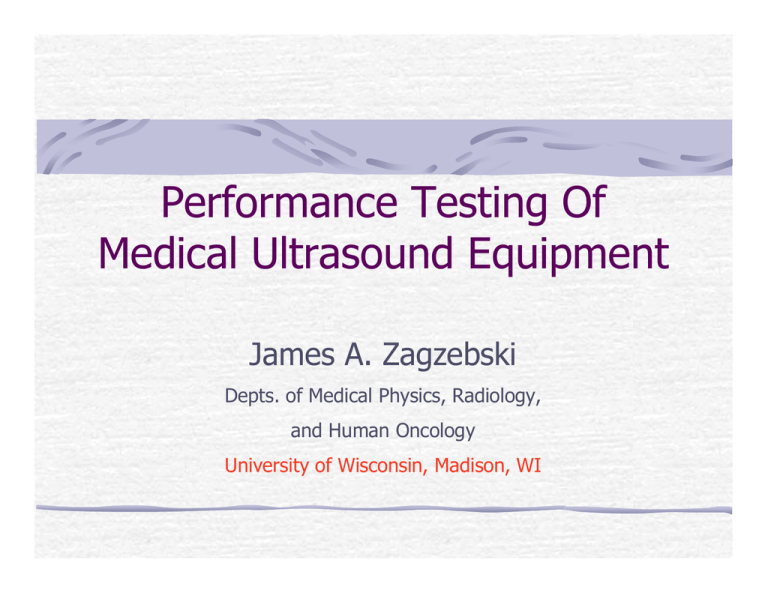
Performance Testing Of Medical Ultrasound Equipment James A. Zagzebski Depts. of Medical Physics, Radiology, and Human Oncology University of Wisconsin, Madison, WI Should we do routine performance testing in ultrasound? Some say “It is not beneficial.” Others believe there is not sufficient manpower, especially in physics and bme. Phantoms are perceived to be expensive and inadequate. Routine performance testing … No established performance standards. Geometry, no problem; image quality is! Lack of correlation between performance parameters and clinical performance. Imaging is simple; specifying performance is complex. Contents Review characteristics of equipment Discuss factors related to physicists measurements of imaging performance Recommend basic QA Discuss role of medical physicists Real-time imaging JAZ tongue 30 frames/s Signal Processing Harmonic Processing f1 Transducer Tissue Acoustic field Frequency f2 Transducer Frequency Tissue After processing Gallbladder Polyp Fundamental Harmonic Standard Transmit Tx Amplify Coded Transmit Tx Amplify Coded Excitation Decode GE 548c Standard Transmit GE 548c Coded Excitation GE Logiq 700 Horizontal spacing: 2 mm, 1 mm, 0.5 mm, 0.25 mm Vertical Spacing: 2 mm, 1 mm, 0.5 mm, 0.25 mm 4 MHz 12 MHz Multiple Transmit Focal Zones L .R . = λ x F D focaldistance distance F F= =focal aperture(transducer) (transducer)size size DD= =aperture wavelength λ λ= =wavelength (smallerfor forhigher higherfrequencies) frequencies) (smaller Point targets in tm material 4 MHz GE C548 transducer 7 MHZ Conventional Transducer 4 mm targets Important Performance Features Geometric accuracy (Not at levels considered previously when static scanners were used) Resolution Uniformity Penetration and sensitivity Low contrast detection Common US phantoms Gel Phantom Material Properties Property Value Degree of Control Density 103 kg/m3 Good SOS 1,540 m/s Very Good Attenuation 0.5 to 0.7 Good dB/cm-MHz Scatter Liver like Good B/A Water-like Fair Water-based Gel Phantoms Gel materials cannot be machined. Even little bubbles cause big problems. Care is needed to avoid desiccation. Alternative Materials Polyurethane rubber stable SOS = 1455 m/s (Too low) Attenuation changes too rapidly with freq. QA tests only? (Goodsitt et al, 1998, Med Physics) Vertical Distance Accuracy Horizontal Distance Accuracy Prostate Implant phantom Dots indicate templates for insertion points. Targets should align with template. (Courtesy of CIRS) Extended Fields 3-D 3-D “Egg-Phantom” Axial Resolution Targets 2 1 ½ ¼ 5 4 3 2 mm 1 ½ (mm) Cautions Regarding Axial Resolution Discrete target separation Scanner performance may fall between target spacing Window material causes reverberations Occasionally see double images of a target Only limited use of quantitation Axial response length (computer or manually) Reverberations from Scanning Surface Lateral Resolution 4mm Tubes (vessels) 2mm 2 3 4 4mm 2mm “Standard Phantom” Attempt (ACR) P Carson E Boote T Johnson A Siebert J Zagzebski E Madsen RMI 408A Spherical Mass Low Contrast Detection -1.5 dB -3 dB Routine QA Program Equipment inspection Penetration into a phantom Gray scale photography (workstation monitor) Image uniformity Distance measurements (where needed) RMI 403 Inspection Transducers free of cracks, delaminations Cables in good shape Transducers cleaned after each use Viewing monitors clean Air filters Wheels, locks Maximum Depth of Visualization Photography (gray bar) 2 3 4 Photography (SMPTE) Image Uniformity (dead elements) Role of The Medical Physicist Role of The Medical Physicist Be knowledgeable in functionality of ultrasound equipment. Be aware of issues related to acoustic output levels. Help establish QA programs. Work beyond routine QA measurements. Mechanical and Thermal Indices (MI and TI) 1992 (US) Acoustic Output Display Std Removed application specific intensity limits Contrast agents (MI) Research mode (NIH)
